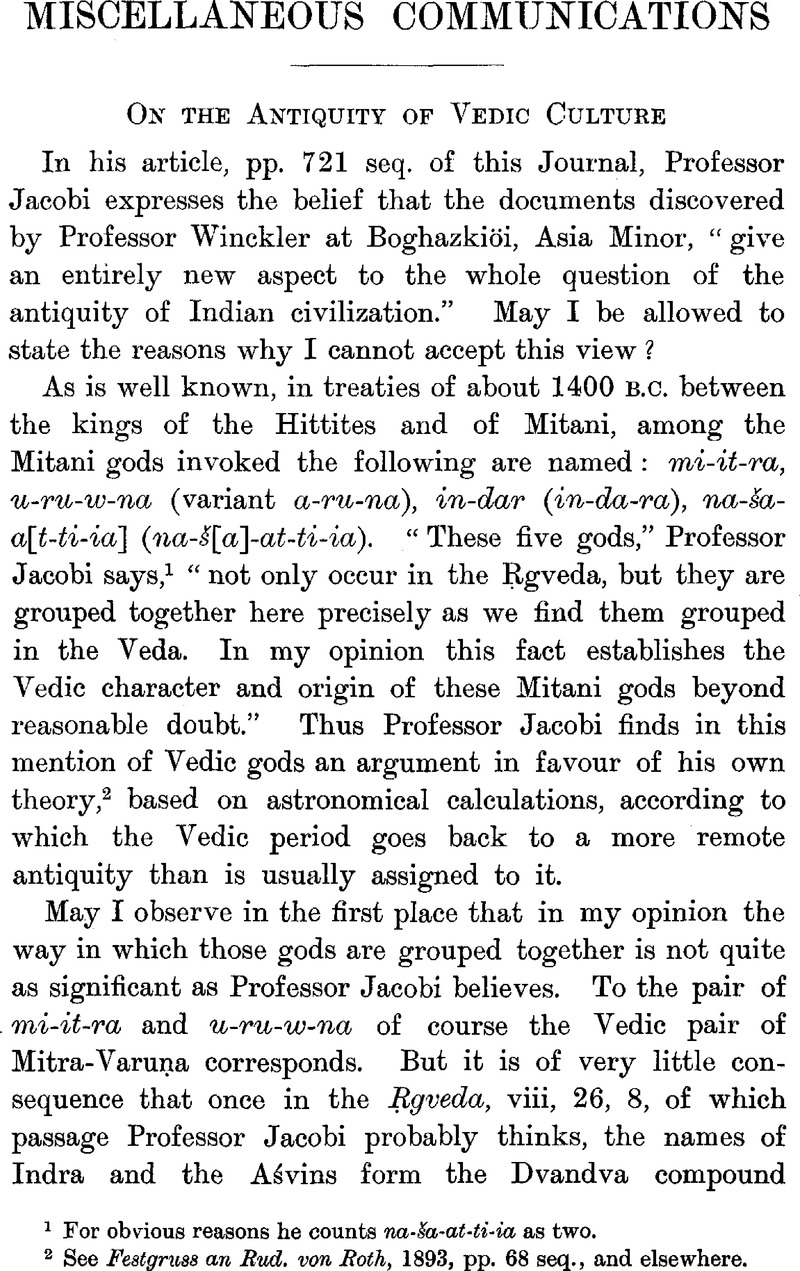No CrossRef data available.
Article contents
On the Antiquity of Vedic Culture
Published online by Cambridge University Press: 15 March 2011
Abstract

- Type
- Miscellaneous Communications
- Information
- Copyright
- Copyright © The Royal Asiatic Society 1909
References
page 1095 note 1 For obvious reasons he counts na-ša-at-ti-ia as two.
page 1095 note 2 See Festgruss are Rud. von Roth, 1893, pp. 68 seq., and elsewhere.Google Scholar
page 1096 note 1 The remarks of Halévy, M., Revue, sémitique, 1908, vol. xvi, pp. 247 seq., do not convince me of the contrary.Google Scholar
page 1096 note 2 “Das erste Auftreten tier Arier in der Geschichte”: Sitzungsberichte der K. Preussischen Akademie der Wissenschaften, 1908, pp. 14 seq.Google Scholar
page 1097 note 1 See Darmesteter, , Ormazd et Ahriman, pp. 44 seq., 62 seq.Google Scholar
page 1098 note 1 By deriving these gods from Iran rather than from India we may possibly account for the absence of Agni. It seems probable that the prominence of Agni in the Veda is of Indian, not of Indo-Iranian, growth.
page 1098 note 2 See Meyer, , Sitzungsberichte, loc. cit., p. 18,Google Scholar n. 2; cf. also Bloomfield, , American Journal of Philology, vol. xxv, p. 11.Google Scholar
page 1098 note 3 Cf. also Šuwardata (not Huvardata), the name of a Palestinian dynast occurring in the Amarna letters (Meyer, , Kuhn's Zeitschrift, vol. xlii, p. 26Google Scholar). Whatever may be our opinion on the theory of Professor Andreas that the ancient Iranian language has preserved the Indo-European triad of vowels a, e, o (Verhandlungen des 13. Internationalen Orientalisten-Kongresses, p. 103Google Scholar), in no case do I think that the vocalism of the names in question furnishes a more valid argument for their Indian origin than the consonants. Else we should have to derive from India most of the Aryan names preserved in Babylonian, etc., inscriptions (see on these names especially ProfessorMeyer's, article, Kuhn's Zeitschrift, vol. xlii, pp. 16 seq.Google Scholar) and also ![]() , etc. (see Bartholomae, , Anzeiger für indog. Sprach- und Altertumskunde, vol. xviii, p. 83Google Scholar), while
, etc. (see Bartholomae, , Anzeiger für indog. Sprach- und Altertumskunde, vol. xviii, p. 83Google Scholar), while ![]() would be Indian by the two α's and Iranian by the π. Or should this a belong exclusively to a certain (the western ?) branch of Iranian dialects ? There would be no difficulty in deriving the names mi-it-ra, etc., from a dialect of that very branch.
would be Indian by the two α's and Iranian by the π. Or should this a belong exclusively to a certain (the western ?) branch of Iranian dialects ? There would be no difficulty in deriving the names mi-it-ra, etc., from a dialect of that very branch.
page 1098 note 4 American Journal of Philology, loc. cit.
page 1099 note 1 I do not pretend, of course, that this is the true date; I only say that such a date would be quite compatible with the god-names of Boghazkiöi, if these are Indian. Professor Meyer places the Aryan immigration into India in the first centuries of the second millennium, and the beginnings of Vedic poetry “not later than 1500 B.C.” I am surprised that Professor Jacobi (p. 725) ascribes to that eminent scholar the opinion “that in the fifteenth century B.C. the Aryan branch of the Indo-Germanic family was as yet undivided”, of which the consequence of course would be that “the Indians cannot have been settled in the Punjab in the fifteenth century B.C. as an independent people”. This theory Professor Jacobi refutes at length, but Meyer's real opinion is very different from what Jacobi states it to be; see Sitzungsberichte, loc. cit., pp. 17–18Google Scholar; Geschichte des Altertums, 1909, 2nd ed., vol. i, pt. ii, pp. 807, 837.Google Scholar
page 1099 note 2 On p. 723 of the same paper he contents himself indeed with concluding from the texts of Boghazkiöi that Vedic civilization was already in its full perfection about the sixteenth century. This estimate may be correct, though I do not think it is proved by those documents.
page 1100 note 1 Festgruss an Roth, p. 72Google Scholar; Nachrichten der Göttinger Gesellschaft der Wissenschaften, 1894, p. 110;Google ScholarZeitschrift der Deutschen Morgenländischen Gesellschaft, vol. xlix, p. 218.Google Scholar




